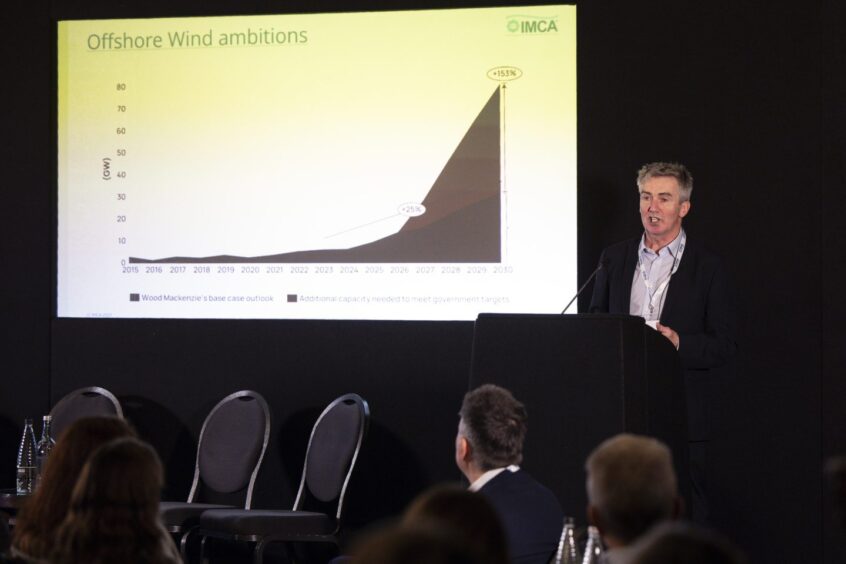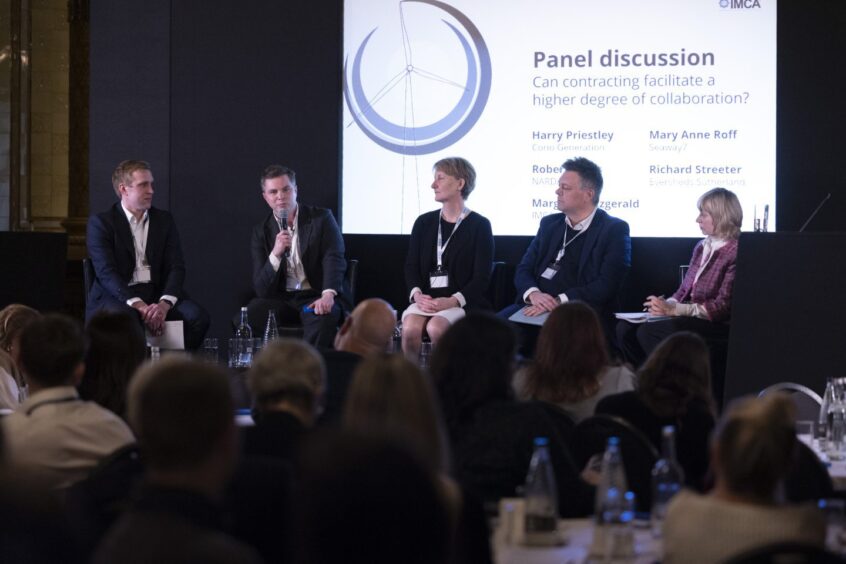
The UK has had a leading advantage in offshore wind for some years, but demand from other parts of the world is growing – and competition becoming keener, International Marine Contractors Association (IMCA) head Iain Grainger has said.
Speaking to Energy Voice on the sidelines of an IMCA seminar, Grainger said targets were outstripping sector capacity.
“There’s global competition now for a scarce set of resources, in terms of developers’ capability and supply chain capability. The UK has to compete against a lot more parts of the world now,” Grainger said, noting new interest from Taiwan, the US, Denmark and Germany.
These countries have “taken much bolder steps” than the UK, he continued. Grainger gave the example of the TenneT grid investment plans, from the German and Dutch governments.
“The UK’s not done that. The UK’s still expecting people to find a grid connection point and fight with permitting. There’s 400 GW in the pecking order for grid connection.”
Valuing offshore wind
In a point echoed by a number of attendees at the IMCA seminar, Grainger said there was a need to value “clean, green, secure energy”, rather than focusing on the “absolute lowest cost. We shouldn’t be importing gas from Russia or Qatar or the US. We should be building our own secure supply chain and green supply chain.”
The IMCA official allowed that there had been some progress from the UK government. Following the failure of AR5 – where no offshore wind contracts were awarded – the government has increased the strike price for the next round, AR6.
In the September offering, the government was offering £44 per MWh for fixed bottom and £116 for floating. For AR6 this will rise to £73 per MWh and £176 respectively.
Grainger welcomed the higher prices as “significant”, saying there should be “enough money for everybody to make a fair return, as well, as there just wasn’t enough money before”. He also noted alternative selection factors, perhaps giving advantages to local content.
The squeeze on project developers leads, inevitably, to a squeeze on the supply chain – who were well represented at the IMCA discussion.
Desperate
Offshore wind growth in 2016-20 came at a time when oil and gas was suffering, driving contractors to redeploy equipment and people to renewables. This drive, though, came at a cost with companies cutting prices in order to win business.
The supply chain was “desperate” at that point, Grainger said. While contractors objected to the contract terms they lacked the power to bargain.
“They weren’t in a position to argue, they were sitting with lots of assets. If your boat’s not working, it’s costing you money. There was a hunger to go and get vessels working,” he continued.
“They found out actually, it would be better if they had just parked their vessels for five years, or four years, and then come back. The losses were bigger than they would have been just to buy the vessels new.”
A line has been crossed
“Contractors today have got a choice, they’ve got a choice about oil and gas versus wind, and they’ve now got an international choice,” Grainger said. “Some contractors are definitely moving back to their comfort zone.” Terms are typically better in oil and gas, he continued.
Overall, there was a sense – from Grainger and others in the room – that contractors were unwilling to take on work at any cost.
Richard Streeter, head of clean energy at Eversheds Sutherland, speaking on a panel said it “feels like the market is shifting. The contractor side is gaining bargaining power, the clients in my world are stepping back and negotiating with contractors who are just saying no. A line has been crossed.”
Developers are “waking up to the fact that the wind is blowing in a different direction”, Streeter continued.
Tool for the job
Seaway7 vice president legal Mary Anne Roff agreed, saying there was “more clarity in our organisation about the level of risk we are prepared to take. There’s a huge amount of ambition but only a limited number of vessels in the world.”
Again and again, speakers talked about the need to rebalance risk and reward. IMCA’s seminar was focused on the launch of a new transport and installation (T&I) contract for the industry.
“Everybody in the industry knows we need something different,” Grainger explained on the contract. “We’re approaching a period now where we’ve got to work differently. The contract is just a tool. We see the huge opportunity out there, so we need the tools.”
The contract focuses on T&I alone, he explained, in recognition of the growing need from the industry. There was a need for a “suite of contracts”, covering all the aspects of the supply chain, “but we wanted to get one out – and one that is probably applicable to our major contractors”.
Developing trust
IMCA is an organisation representing the supply chain. To break through and secure wider approval will be a challenge and can only be done in stages.
Furthermore, IMCA is not alone in providing a model contract, Grainger noted it was one of six. Going on discussion at the seminar, FIDIC’s contract was a current favourite – although it is limited. For instance, the standard model covers only onshore wind, with plans to launch an offshore version by the end of 2025.
“We think it’s a good starting point, for someone that doesn’t have an in-house contract,” Grainger said and should go some way to reducing negotiating time.
There is a need for developers and contractors to work together, through early engagement. “Choose your suppliers early, and work with them on a longer term basis,” he said. “Develop deeper relationships with a smaller number of key suppliers. You’ve got to build huge trust, because you’ve got to trust that they’re not going to screw you over.”
Corio Generation’s Harry Priestley, speaking on the panel, said his company wanted a “sustainable supply chain … we’re looking for ways to engage much earlier, two to three years before work begins to increase the amount of time we have. But contracting before consent is very difficult. But we’re all ears, we’re listening. The next move will be to not be transactional, to not do this on a per project basis. That would be great, but one step at a time.”
Recommended for you


 © Supplied by IMCA
© Supplied by IMCA